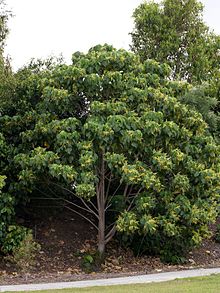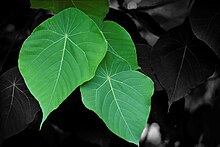You can help expand this article with text translated from the corresponding article in Indonesian. (January 2023) Click for important translation instructions.
|
| Macaranga tanarius | |
|---|---|

| |
| Macaranga tanarius - leaves | |
| Scientific classification | |
| Kingdom: | Plantae |
| Clade: | Tracheophytes |
| Clade: | Angiosperms |
| Clade: | Eudicots |
| Clade: | Rosids |
| Order: | Malpighiales |
| Family: | Euphorbiaceae |
| Genus: | Macaranga |
| Species: | M. tanarius |
| Binomial name | |
| Macaranga tanarius (L.) Müll.Arg., 1866 | |
| Synonyms | |
| |
Macaranga tanarius is a plant found in South East Asia, Thailand, Papua New Guinea, South China, Taiwan, and eastern Australia. It is commonly seen as a pioneer species in disturbed rainforest areas. Easily recognised for the round veiny leaves. In Australia it naturally occurs from the Richmond River, New South Wales to Cooktown in tropical Queensland.
Some of the many common names include parasol leaf tree, blush macaranga, nasturtium tree, David's heart and heart leaf.
Description
It is a shrub or bushy tree, sometimes reaching 12 metres tall and with a stem diameter of 40 cm. The trunk is short and crooked, bark being grey-brown, with bumps and irregularities. The branchlets are smooth, bluish grey with prominent leaf scars.
Leaves are alternate, and round with a tip, 8 to 23 cm long, greyish or white on the underside. It has prominent leaf stalks 8 to 20 cm long which connect within the leaf itself. Nine main veins radiate from the leaf stalk, easily noticed on the upper and lower leaf side.
Yellow-green flowers form on panicles in the months of October to January (in New South Wales). Female and male flowers grow on different trees. The fruit is a prickly three-celled yellow capsule, 9 mm in diameter, maturing in January to February (in New South Wales). There is one black seed in each of the cells. Germination from fresh seed occurs without difficulty. Cuttings strike well.

Uses
An attractive ornamental tree with interesting leaves. Also well regarded by bush regenerators to provide shade for juvenile trees.
Its bark contains tannins that are used as a colorant: it is used to dye nets, mats, as a kind of house paint, or as a leather preservative in tanning.
In the Philippines, particularly in the Ilocos Region and Apayao, the tree locally known as samak is widely used in producing traditional basi (a sugarcane-based rum) and local vinegar. Various parts of the tree, including its dried leaves, bark, fruits, and flowers, are used as fermenting, coloring, and flavoring agents during the fermentation process.
Gallery
-
 Macaranga tanarius - foliage and flowers.
Macaranga tanarius - foliage and flowers.
-
 Unidentified objects on some leaves.
Unidentified objects on some leaves.
-
 Fruits.
Fruits.
-
 Bract.The flower of Macaranga tanarius has no petals.
Bract.The flower of Macaranga tanarius has no petals.
References
- NRCS. "Macaranga tanarius". PLANTS Database. United States Department of Agriculture (USDA). Retrieved 25 June 2015.
- Purwaningsih & S. Sukardjo. 1991. "Macaranga tanarius (L.) Muell. Arg." In: R.H.M.J. Lemmens and N. Wulijarni-Soetjipto (Eds). Plant Resources of South-East Asia No. 3: Dye and tannin-producing plants: 88-9. Pudoc, Wageningen, The Netherlands. ((Internet) Record from Proseabase)
- ^ Blust, Robert; Trussel, Stephen (2010). "*samak a tree and a tannin that it yields: probably Macaranga tanarius". Austronesian Comparative Dictionary. Max Planck Institute for Evolutionary Anthropology. Retrieved 8 November 2022.
- Galano, Marvin M.; Sanidad, Remely A.; Liberato, Milagros O. (2022). "The Effects of Tree Barks in the Fermentation of Sugarcane". International Journal of Natural Sciences: Current and Future Research Trends. 14 (1): 70 – via International Scientific Research and Researchers Association.
- PlantNET - The Plant Information Network System of Botanic Gardens Trust, Sydney, Australia - July 19, 2009.
http://plantnet.rbgsyd.nsw.gov.au/cgi-bin/NSWfl.pl?page=nswfl&lvl=sp&name=Macaranga~tanarius
- Floyd, A. G. (1989). Rainforest Trees of Mainland South-eastern Australia (1st ed.). Port Melbourne: Elsevier Australia - Inkata Imprint, copyright Forestry Commission of New South Wales (published 1989-12-01). p. 149. ISBN 0-909605-57-2. Retrieved 2009-07-18. (other publication details, included in citation)
| Taxon identifiers | |
|---|---|
| Macaranga tanarius |
|
| Ricinus tanarius | |